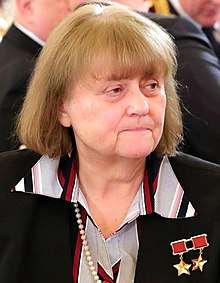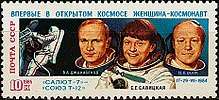Svetlana Savitskaya
Svetlana Yevgenyevna Savitskaya (Russian: Светла́на Евге́ньевна Сави́цкая; born 8 August 1948) is a retired Soviet aviator and cosmonaut who flew aboard Soyuz T-7 in 1982, becoming the second woman in space. On her 1984 Soyuz T-12 mission she became the first woman to fly to space twice, and the first woman to perform a spacewalk.
Svetlana Savitskaya | |
|---|---|
 Savitskaya in the Moscow Kremlin, 2018 | |
| Born | 8 August 1948 |
| Nationality | Soviet / Russian |
| Other names | Svetlana Yevgenyevna Savitskaya |
| Occupation | Flight engineer, politician |
| Awards | Hero of the Soviet Union |
| Space career | |
| Cosmonaut | |
Time in space | 19 days 17 hours 06 minutes |
| Selection | 1980 (Female Group 2) |
Total EVAs | 1 |
Total EVA time | 3 hours 35 minutes |
| Missions | Salyut 7-EP2 (Soyuz T-7 up, Soyuz T-5 down), Salyut 7-EP4 (Soyuz T-12) |
Mission insignia | |
| Signature | |

She set several FAI world records as a pilot.
Early life and early career
Svetlana Savitskaya was born in a privileged family. Her father, Yevgeny Savitsky, was a highly decorated fighter pilot during the Second World War, which later brought him to the position of Deputy Commander-in-Chief of Soviet Air Defense.
Without the knowledge of her parents, Savitskaya began parachuting at the age of 16. When her father heard about it, he further promoted this tendency. On her seventeenth birthday she already had 450 parachute jumps. Over the next year, she led record stratosphere jumps from 13,800 m and 14,250 m.[1]
After graduating in 1966, she enrolled in the Moscow State Aviation Institute (MAI), where she also took flight lessons. In 1971 she was licensed as a flight instructor. After graduating from the MAI in 1972, she trained as a test pilot at the Fedotov Test Pilot School, graduating in 1976.[1][2] In May 1978 she went to work for the aircraft manufacturer Yakovlev, as a test pilot.
Between 1969 and 1977 she was a member of the Soviet national team for aerobatics. At the FAI World Aerobatic Championships in July 1970 at Hullavington, she flew a Yak-18 and won the world championship together with an all-female team. At the 1972 World Championships in Salon-de-Provence she placed third; in 1976 in Kiev with a Yak-50, fifth.[3]
Soviet space program
.jpg)
In 1979, Savitskaya participated in the selection process for the second group of female cosmonauts. On June 30, 1980, she was officially admitted to the cosmonaut group. She passed her exams on February 24, 1982.
First flight: Soyuz T-7 / T-5
In December 1981, Savitskaya prepared for her first space flight, a short-term flight to the space station Salyut 7, replacing the original crew. The commander of this mission was Leonid Popov, with his third flight; it was flight engineer Alexander Serebrov's first flight.
The launch of Soyuz T-7 took place on August 19, 1982. This made Savitskaya the second woman in space, 19 years after Valentina Tereshkova. The three cosmonauts docked with the space station the following day, where they were welcomed by Anatoly Berezovoy and Valentin Lebedev. This was the first time a space station had a mixed gender crew. Savitskaya was assigned the orbital module of Soyuz T-7 as a private area, but slept as well as the men in the space station. On August 27, 1982, Popov, Savitskaya, and Serebrov returned to Earth in Soyuz T-5.
In 1995, Savitskaya gave an interview to Baltimore Sun journalist Clara Germani. She recalled encountering some sexism from her male crewmates and that upon entering Salyut 7 for the first time, Valentin Lebedev presented her with an apron and told her "to get to work". She stated that "I was quickly able to establish a working, professional relationship with them."
Second flight: Soyuz T-12
In December 1983 she was assigned to her second flight, including an EVA, three weeks after American astronaut Kathy Sullivan's flight and EVA assignment were made public.[4] Again, it was to be a short-term mission to Salyut 7, this time bringing tools to the station so that the third resident crew, the Salyut 7 EO-3, could repair a fuel line.
On July 17, 1984 Savitskaya launched aboard Soyuz T-12, together with Commander Vladimir Dzhanibekov and research cosmonaut Igor Volk. On July 25, 1984, Savitskaya became the first woman to spacewalk, conducting EVA outside the Salyut 7 space station for 3 hours and 35 minutes, during which she cut and welded metals in space along with her colleague Vladimir Dzhanibekov.[5][6] Of the 57 Soviet/Russian spacewalkers through 2010, she is the only woman, and as of April 2020 is still the only Soviet/Russian woman to walk in space. The return to Earth took place on July 29, 1984.
Savitskaya recalled that, during her second mission, she expressed concern about the extravehicular welding exercises, as "I did not understand the point of it. We might burn our spacesuits or the exterior of the station." but her overall excellent performance on both flights silenced critics who questioned a woman's capability to perform space missions.[7]
Possible third spaceflight
Upon returning to Earth, Savitskaya was assigned as the commander of an all-female Soyuz crew to Salyut 7 in commemoration of International Women's Day. In February 1985, however, the radio contact with Salyut 7 was lost; the space station was rescued by the Soyuz T-13 mission in the summer of 1985. When the next mission had to be stopped in November 1985, due to an illness of the commander Vladimir Vasyutin, the women's flight was finally canceled. In addition, after two unsuccessful flights in 1983, Soyuz T-8 and Soyuz T-10-1, not enough Soyuz spacecraft were available. Later it would have been possible to fly with a Soyuz-TM to the space station Mir. However, this plan was not pursued due to Savitskaya's pregnancy in 1986.
Biography
Savitskaya is married, with one child, a son born in 1986.[8] In February 1986, she graduated from the Bauman Moscow Higher Technical School. From 1983 to 1994 Savitskaya held a position of Deputy Head of NPO Energia.[9]
A committed communist, Savitskaya was elected as a people's deputy of the USSR from 1989 and a people's deputy of Russia in 1990, a position she held until 1992.[10][11] She did not welcome the collapse of the Soviet Union in the early 1990s, noting that everything her parents had worked hard to build was destroyed almost overnight and she was "glad they did not live to see it".[7]
Savitskaya retired in 1993 from the Russian Air Force with the rank of Major. In 1994/95 she worked as an Assistant Professor in Economics and Investment at the Moscow State Aviation Institute. In 1996, she was elected a deputy of the State Duma representing the Communist Party of the Russian Federation, and has been re-elected four times since then. She presently serves as Deputy Chair of the Committee on Defence, and is also a member of the Coordination council presidium of the National Patriotic Union.[11]
FAI World Records[12]
| Date | Class | Discipline | Plane | Result |
|---|---|---|---|---|
| June 6, 1974 | turbojet | Climb to 6000 m | MiG-21 | 1:20.4 min |
| June 6, 1974 | turbojet | Climb to 9000 m | MiG-21 | 1:46.7 min |
| June 7, 1974 | turbojet | Climb to 3000 m | MiG-21 | 0:59.1 min |
| June 7, 1974 | turbojet | Climb to 12000 m | MiG-21 | 2:35.1 min |
| November 15, 1974 | rocket plane | Climb to 3000 m | MiG-21 | 0:41.2 min |
| November 15, 1974 | rocket plane | Climb to 9000 m | MiG-21 | 1:21 min |
| November 15, 1974 | rocket plane | Climb to 12000 m | MiG-21 | 1:59.3 min |
| June 2, 1975 | turbojet | Speed over 15/25 km | MiG-25 | 2683.45 km/h |
| August 31, 1977 | turbojet | Altitude in horizontal flight | MiG-25 | 21,209.9 m |
| October 21, 1977 | turbojet | Speed over circuit of 500 km | MiG-25 | 2466.31 km/h |
| April 12, 1978 | turbojet | Speed over circuit of 1000 km | MiG-25 | 2333 km/h |
| January 17, 1979 | internal combustion plane | Climb to 3000 m | Yak-50 | 4:21.4 min |
| April 23, 1981 | turbojet, take-off weight 16–20 tons | Payload at 2000 m altitude | Yak-40K | 5012 kg |
| April 24, 1981 | turbojet, take-off weight 12–16 tons | Payload at 2000 m altitude | Yak-40K | 4084 kg |
Honours and awards
- Hero of the Soviet Union, twice (1982, 1984)
- Orders of Lenin, twice (1982, 1984)
- Order of the Badge of Honour (1976)
- Medal "For Merit in Space Exploration" (12 April 2011) – for great achievements in the field of research, development and utilization of outer space, many years of honest work, public activities
- Pilot-Cosmonaut of the USSR
- Honoured Master of Sports
- Gold Medal and 18 degrees FAI
- 16 gold medals, sports of the USSR
- Special medal for the women's world record stay in space
- Honorary Citizen of Baikonur (1982)[13]
Savitskaya was one of five cosmonauts selected to raise the Russian flag at the Sochi 2014 Winter Olympics opening ceremony.[14]
The asteroid 4118 Sveta is named after her.[15]
See also
- List of female astronauts
- List of female Heroes of the Soviet Union
References
- Evans, Ben (2012). Tragedy and Triumph in Orbit: The Eighties and Early Nineties. Springer Science & Business Media. p. 614. doi:10.1007/978-1-4614-3430-6. ISBN 9781461434306.
- Знаменская, Наталья, ed. (2002). ШЛИ со временем [ShLI in Time] (in Russian) (2 ed.). Жуковский: ООО "Редакция газеты "Жуковские вести". p. 400.
- Umberto Cavallaro - Women Spacefarers: Sixty Different Paths to Space, Springer, 2017. ISBN 3319340476
- "A Cog in a Political Machine: The Career of Svetlana Savitskaya". AmericaSpace. 2012-02-10. Retrieved 2018-03-21.
- "Biographies of USSR / Russian Cosmonauts". Space Facts. 9 August 2012. Retrieved 18 February 2014.
- "Space welding anniversary!". Orbiter-Forum. Jelsoft Enterprises Ltd. 16 July 2009. Retrieved 18 February 2014.
- "Space heroine as hard-line hopeful Russian election: Svetlana Savitskaya, the first woman to walk in space, is a top Communist candidate in the once all-powerful party's comeback bid in the Duma". baltimoresun.com.
- "Nothing But The Facts About: Svetlana Savitskaya". Brighthub. Retrieved April 12, 2014.
- "S.P. Korolev RSC Energia - News". www.energia.ru (in Russian). Retrieved 2018-03-21.
- "Pilot-cosmonaut of the USSR, Svetlana Savitskaya, turns 65". Russian Aviation. 9 August 2013. Archived from the original on 7 October 2013. Retrieved 20 April 2017.
- "Duma Deputies Alphabetical Listing". Archived from the original on 3 March 2016. Retrieved 20 April 2017.
- "Records | World Air Sports Federation". fai.org. Fédération Aéronautique Internationale. Retrieved 2018-03-21.
- "Почетные граждане города" [Honorary citizens of the city]. baikonuradm.ru (in Russian). Baikonur City Administration. Retrieved 2019-02-21.
- "The XXII Olympic Winter Games in Sochi in 2014 has opened with a grand show". Sochi2014.com. 8 February 2014. Retrieved 11 February 2014.
- Schmadel, Lutz D. (2003). Dictionary of Minor Planet Names, Volume 1. New York: Springer. p. 352. ISBN 3-540-00238-3.
External links

- Interview shortly before her 1995 election to the State Duma
- 2010 interview with The Voice of Russia radio website